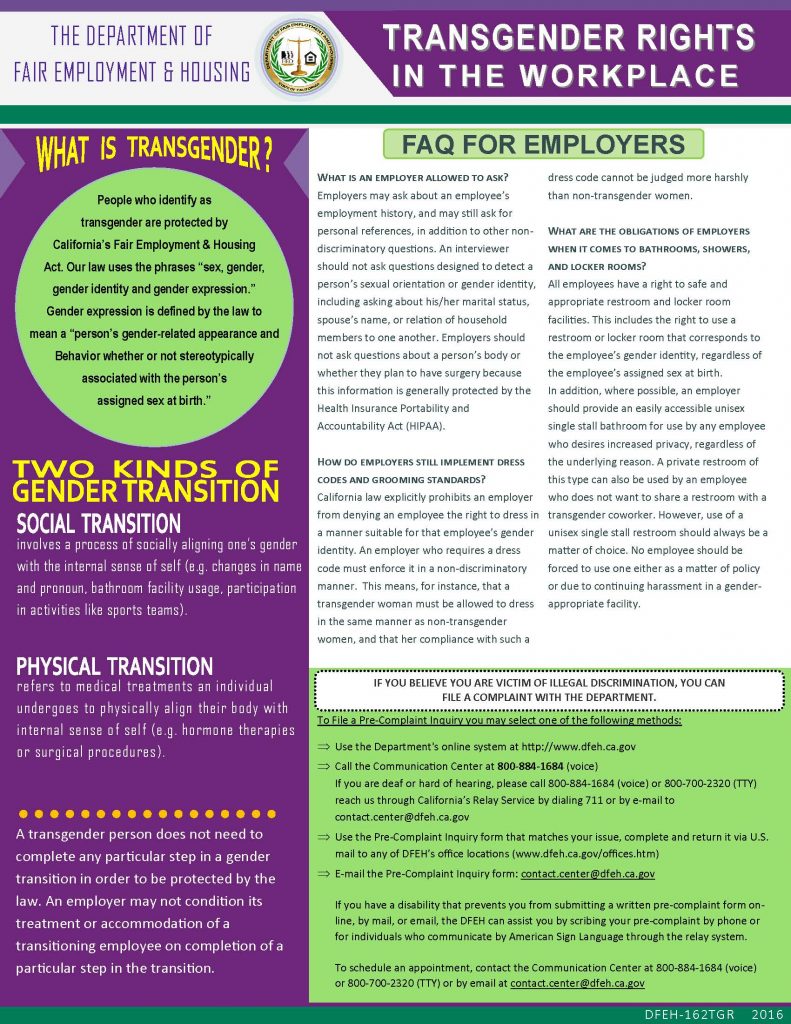
An estimated 0.3% of adults are transgender. Many face pervasive harassment, discrimination, violence, and abuse in every aspect of their lives, including at work, in housing, education, healthcare, and personal relationships. Consider the discrimination suffered by transgender individuals at work. According to a comprehensive 2011 report titled “Injustice At Every Turn: A Report of the National Transgender Discrimination Survey“:
- 90% of transgender individuals surveyed reported experiencing harassment, mistreatment or discrimination on the job or took actions like hiding who they are to avoid it.
- 47% said they had experienced an adverse job outcome, such as being fired, not hired or denied a promotion because of being transgender or gender non-conforming.
- Over one-quarter (26%) reported that they had lost a job due to being transgender or gender non-conforming and 50% were harassed.
- Large majorities attempted to avoid discrimination by hiding their gender or gender transition (71%) or delaying their gender transition (57%).
- Overall, 16% said they had been compelled to work in the underground economy for income (such as doing sex work or selling drugs).
- Respondents who had lost a job due to bias also experienced ruinous consequences such as four times the rate of homelessness, 70% more current drinking or misuse of drugs to cope with mistreatment, 85% more incarceration, more than double the rate working in the underground economy, and more than double the HIV infection rate, compared to those who did not lose a job due to bias.
- A staggering 41% of respondents reported attempting suicide compared to 1.6% of the general population, with rates rising for those who lost a job due to bias (55%), were harassed/bullied in school (51%), had low household income, or were the victim of physical assault (61%) or sexual assault (64%).
California has protected transgender employees from workplace and housing discrimination for over a decade. It has done so through the Fair Employment and Housing Act (FEHA), which prohibits discrimination, harassment, and retaliation based on certain protected categories. However, many Californians remain unaware that transgender employees are protected from workplace discrimination. To help educate workers and employers, the California Legislature made these protections explicit in 2003 and 2011. And, this week, California’s Department of Fair Employment and Housing issued guidance in a one-page brochure that is clear and easy to understand.
History of the Fair Employment and Housing Act and Its Protections for Transgender Employees
California first passed the predecessor to the FEHA (then called the Fair Employment Practices Act) in 1959. It prohibited discrimination in employment based on race, religion, color, national origin, and ancestry. Over the years, the FEHA has been expanded to protect employees from other forms of discrimination, including discrimination based on age, physical disability, mental disability, medical condition, genetic information, marital status, sex, gender, gender identity, gender expression, sexual orientation, or military and veteran status.[1]
In 2003, the California legislature amended the FEHA to include gender in its definition of “sex.” It incorporated by reference then-Penal Code section 422.76, which defined gender as “the victim’s actual sex or the defendant’s perception of the victim’s sex, and includes the defendant’s perception of the victim’s identity, appearance, or behavior, whether or not that identity, appearance or behavior is different from that traditionally associated with the victim’s sex at birth.”
The legislative history reflected the need for the bill:
According to the sponsor, “[d]iscrimination is wrong and hurts all Californians, especially when it is based on characteristics like gender identity or expression that have nothing to do [with] one’s qualifications as an employee or a tenant. This bill will provide protection to those who are fired, evicted, or harassed every day because they exhibit traits not stereotypically associated with their sex at birth. Such traits may include a person’s personality, clothing, hairstyle, speech, mannerisms, or demeanor; they may also include a person’s characteristics such as vocal pitch, facial hair, or the size and shape of a person’s body. This will protect men who are seen as ‘too feminine’ and women perceived as ‘too masculine.'”
Bill supporters explained that while some courts had already interpreted sex discrimination laws to include gender as a protected category, codifying these protections would ensure that those in need of protections would understand that they are protected, and would help inform employers and others who were unaware that such discrimination was prohibited.
In 2011, the California Legislature amended the Fair Employment and Housing Act (FEHA) to specifically name as protected categories “gender,” “gender identity,” and “gender expression.” Yet again, these changes primarily clarified existing protections to ensure that there was no ambiguity about workplace protections. Gender expression was defined in the FEHA to mean “a person’s gender-related appearance and behavior whether or not stereotypically associated with the person’s assigned sex at birth.”
The author of the bill explained the importance of the amendment:
Nearly 70% of transgender Californians have experienced discrimination or harassment at work. Californians who experience discrimination based on gender identity and gender expression at work or elsewhere often times do not file complaints because they are unaware that they are protected. Existing anti-discrimination laws are confusing and vague for employers, housing authorities and others who bear the responsibility of ensuring that the laws are enforced. Therefore, the harms caused by discrimination can be reduced by simply using language that is direct and easily understood. AB 887 makes our anti-discrimination laws clearer and stronger by adding gender identity and gender expression to the list of protected categories.
DFEH Guidance on Transgender Rights in the Workplace
While these workplace protections have been in place for over a decade, education remains necessary. This week, the DFEH issued a brochure that provides guidance on transgender rights in the workplace. It confirms that employees are protected based on “sex, gender, gender identity and gender expression,” and it defines gender expression.
It explains that there are two kinds of gender transition:
SOCIAL TRANSITION involves a process of socially aligning one’s gender with the internal sense of self (e.g. changes in name and pronoun, bathroom facility usage, participation in activities like sports teams).
PHYSICAL TRANSITION refers to medical treatments an individual undergoes to physically align their body with internal sense of self (e.g. hormone therapies or surgical procedures).
The guidance makes clear that: “A transgender person does not need to complete any particular step in a gender transition in order to be protected by the law. An employer may not condition its treatment or accommodation of a transitioning employee on completion of a particular step in the transition.”
The guidance includes a three-question FAQ for employers. First, it addresses what questions an employer is allowed to ask (no questions about a person’s sexual orientation or gender identity). Second, it explains how employers can still implement dress codes and grooming standards (by enforcing them in a non-discriminatory manner). Third, it explains obligations that employers have when it comes to bathrooms, showers, and locker rooms, confirming that all employees have a right to safe and appropriate restroom and locker facilities and that they must be allowed to use the facilities that correspond with their gender identities. Employers are encouraged to provide unisex single-stall bathrooms, but cannot require transgender individuals to use them.
Finally, the DFEH points out that employees who have been subjected to illegal discrimination can file a complaint with the DFEH. (They can also hire an attorney to pursue their rights.)
The brochure can be found on the DFEH’s website, along with the other brochures and posters issued by the DFEH.
* * *
[1] To learn more about the history of the FEHA, read the fascinating article by Ann Noel, Fair Employment & Housing Commissioner Executive & Legal Affair Secretary, and Phyllis Cheng, former Department of Fair Employment Director, titled “Through Struggle to the Stars: A History of California’s Fair Housing Law”.


